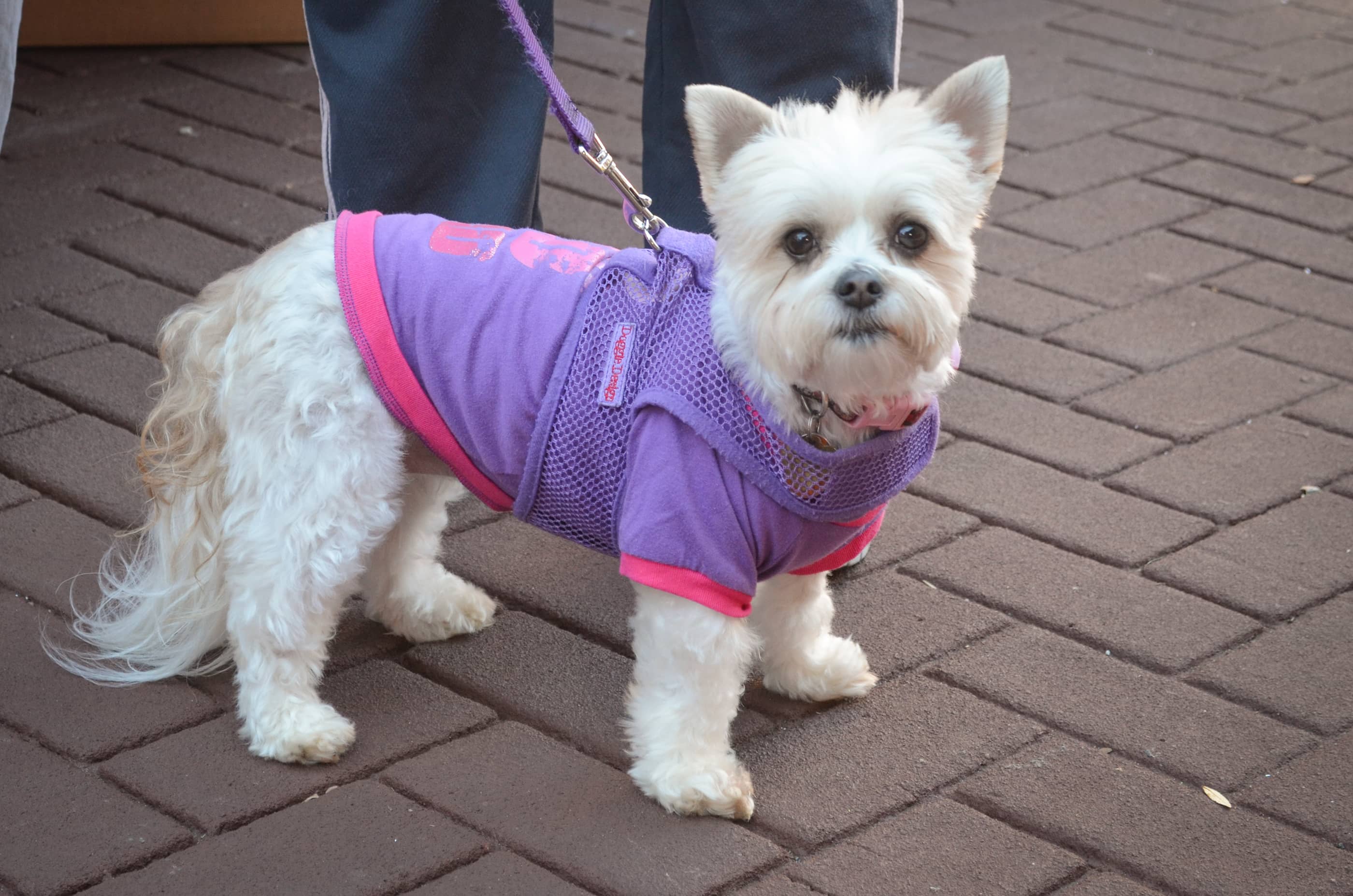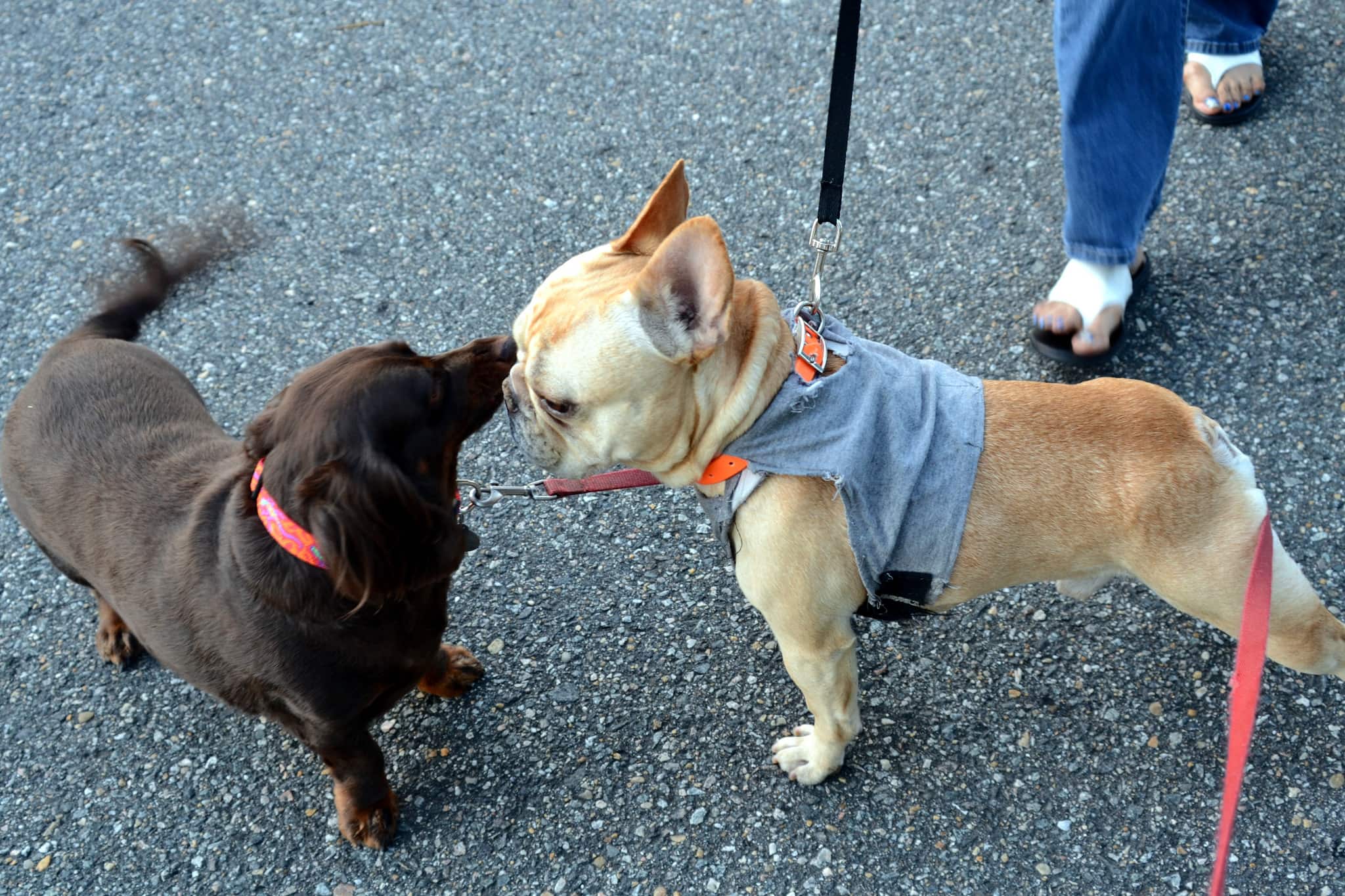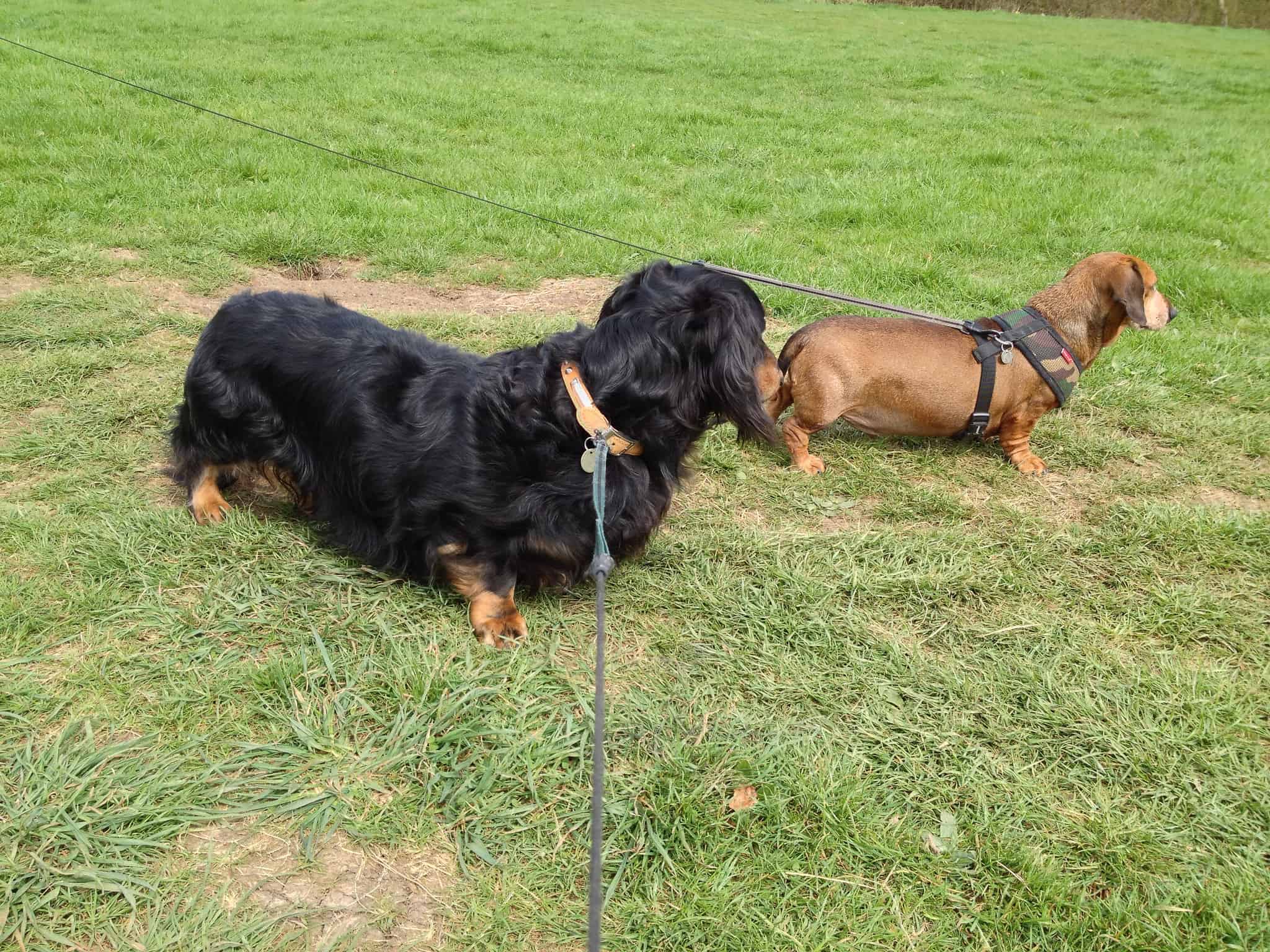How can I make walks more enjoyable for my dog?

I finish up my workout and head straight to the basket full of dog toys.
My Pitbull mix, Koda, lifts his head as I reach into it, he knows what’s coming next.
I pull out his leash and harness, which I must’ve lazily thrown into the toy bin this morning as I rushed for work. Koda bounds over with a stupid grin across his muzzle, fighting every urge in his body to jump on me.
It’s time for a walk!
On the opposite side of the spectrum, my bulldog Rowdy doesn’t even move the couch…unless it’s to run to his crate to hide. There’s a vast difference in opinion on walks between my dogs, but I’ve learned how to make them enjoyable experiences for both, as well as myself.
Koda is one tough cookie, he pulls like no tomorrow most of the time but with a lot of consistency I’ve gotten him to behave. The trick with him is taking the same route, no surprises, no frills. For Rowdy, I need to take his anxieties into consideration. He behaves well no matter what, but if I want to enjoy the walk…it needs to be somewhere quiet.
I’ve learned over time that not all dogs enjoy going for walks - for all sorts of reasons. Some careful observation revealed Koda and Rowdy’s quirks with walks, but it was only after a made a few mistakes first.
Learning and understanding why walks are important for your dog’s overall health is the first step to determining how to make them more enjoyable.
You can make walks more enjoyable for your dog by varying the route, bringing a friend along, taking breaks, adding in toys and treats, and addressing any issues your canine might have before the walk.
Why your dog needs exercise
Let’s begin with why you should be exercising your dog in the first place. The benefits of regular exercise for your dog sound a lot like the benefits it has for humans.
According to the Association for Pet Obesity Prevention, “An Estimated 60% of Cats and 56% of Dogs in the United States are Overweight or Obese.” Your dog probably spends a lot of his day like mine do - sprawled across the couch while I’m at work sitting at a desk. At the end of the day we could all benefit from some movement.
Exercise helps with the obvious: diminishing weight, increasing blood flow, building lean muscle mass, and so much more. For a list of more benefits check out this great article from Animal Wellness Magazine that will motivate you to get you and your dog moving.
All these great benefits help reduce your dog’s risk of disease and create a healthier heart, which means more time with your favorite fur child.
Mental health benefits
Obviously the physical benefits of exercise are well-known for your dog. But if you’re not totally convinced that a walk with help your dog much, consider the mental aspect. If your dog isn’t particularly active (maybe you have a toy breed) that doesn’t require much exercise, remember that their brain still needs stimulation.
Ditch the notion of an intense hike or run and try out a leisurely stroll. The new sights, sounds and scents are sure to send your dog’s brain into a frenzy of fun.
My dog, Koda, thrives on exercise. But when he’s already tired or maybe the weather isn’t too great, I remind myself that at the very least I can exercise his brain. While some choose to do this with treats and brain games, walks are a great solution. Since Koda is part hound, the new smells work his brain the entire time we stroll and even though we don’t have a rigorous walk, he’s still sleeps like a baby that night.

Meeting new dogs on a walk is a great way for you and your pup to make friends. Image: Tony Alter
What if my dog doesn’t like walks?
Not all dogs are jumping with joy and dragging their leashes over to you like Pongo in 101 Dalmations. Just like humans, dogs have varying energy levels, interests, and motivators. But when it comes to taking walks, we can do our best to persuade our furry friends that they’re not so bad afterall.
Reasons why your dog may not want to walk
Before you can begin building interests in walks, you must first identify (if you can) why your dog doesn’t like going for walks in the first place.
Stubborn
Some dogs are just pig-headed and don’t want to do much. My bulldog can sometimes fit this reason and I just have to decide whether it’s worth the debate with him.
Anxiety
If big crowds makes you anxious and nervous, are you going to willingly be part of one if you don’t have to? The same works for your dog. Maybe he’s nervous about new surroundings, loud noises, or encountering strangers. Being aware of these anxieties will allow us to reduce the chances of exposing our dog to them and slowly helping them overcome the anxiety triggers.
Pain
Dogs in pain don’t want to move and who can blame them? Older dogs can be arthritic, making walking a painful chore. The good news is the exercise helps ease the pain of arthritis, the hard part is getting your dog comfortable enough to begin walking.
Illness
A sick dog won’t have the energy to exercise or go for a walk. Dogs display pain in different ways from humans, so while he may not appear sick, if this behavior crops up out of nowhere then you should consult your vet.
Tired
Maybe your dog is just tired and doesn’t have the energy. It really can be that simple and typically is just a temporary thing.
Puppies and walks
We’ve all seen that adorable puppy out with his new owner. He can’t be bothered to walk so he plops down right where he stands and begins chewing on the leash. Your first thought may be that your puppy doesn’t like going on walks, but the simple truth is that they’re just a puppy. He know any better right now.
All dogs need to be trained to walk on a leash and it doesn’t happen overnight. Keep taking him out and insisting he walk on. Encourage him when he does well and keep a sense of a humor - puppies will be puppies.
Adult dogs
Like humans, dogs can get sick of routine. While many thrive on having a schedule, try to not be too rigid with your walks. Our furry-friends are much more perceptive than people think they are. If you walk your dog at the same time every day on the same route, he may just get tired of the situation and lose interest.
Elderly dogs
As your dog ages, his body slows down. Joints begin to ache and his endurance doesn’t quite stand up to where it had been. It may not be as comfortable and easy to get outside for a nice walk as it was before, but there are benefits to keeping an aging dog moving.
The trick is to go slowly, be aware of your elderly dog’s struggles and adapt to them. I’d recommend adding a glucosamine supplement to his diet to help lessen joint pain.
How can I make walks more enjoyable for my dog?
There is no one-size fits all remedy for a walk-averse dog, but there are plenty of options at your disposal to make walks more appealing. It requires you to do a bit of research and observing to narrow down which methods will work best for your dog’s needs.
Vary the route
Doing the same loop around the block every day may cause your dog to become “sour” to walks. There’s nothing new in that route after awhile and the excitement in once held can fizzle out.
For example, when I realized my bulldog didn’t enjoy walks due to his fear of vehicles, I knew walking him around our busy neighborhood wasn’t the best option to get him to overcome his distaste of the exercise before confronting the traffic problem.
I did this by changing where we walked. I drove to a local walking trail with plenty of wooded trails to peruse and entice his senses. Rowdy’s fear of the leash meaning traffic was dispelled as he soon began to associate walking with new places to explore and no traffic.
Plus, my Pitbull mix Koda was enthralled with the new spaces as well. His hound nose was glued to the ground and his tail would not stop wagging.
Changing up the route you take is a great way to keep your dog interested on a daily basis. Image: HackBitz
Bring treats and toys!
Not only are treats a great way to train your dog to walk well on a leash, but they’re fantastic for getting them out of the house in the first place! I don’t know about you, but my dogs are seriously food motivated. They’ll do anything for a snack - kinda like me.
When your dog puts on his harness, give him a treat or toss his favorite ball. When he walks outside nicely, do it again. Rewarding a good behavior is the best to turn a dog into a walking enthusiast.
Bring a friend or brave the trail solo
If you tend to take your dog on walks alone and he’s lagging in interest, consider asking a friend and their dog to tag along. This encourages socialization and brings a new life to your walk. Everything can be made more fun with a friend.
On the inverse, a dog that is leash reactive or fearful of other dogs while walking should be taken out solo. I’ve noticed that Koda behaves better if I do not take Rowdy on walks with him. Just in the sense that he doesn’t pull as much and our leash training is more effective since he’s more apt to listen.
I always take Koda out solo at least twice a week to brush up on his manners since Rowdy is always a well-behaved walker. A quiet trail is best for these scenarios and provides plenty of great one-on-one time for training.
Take breaks
The best part of a tabata workout is the break between sets. It’s what makes them a great and achievable exercise routine for humans. The same ideology around breaks can be applied to your dog.
Rowdy can’t walk for miles on end, bulldogs aren’t built for it. So I make sure to stop, let him take a breather and offer him some water. This gives him time to relax, catch his breath, and be able to continue the walk happily. If he’s struggling for air or is getting exhausted, it can turn the entire walk into a poor experience for him.
Walks are more than just exercise for your dog
Taking your dog out for a walk is more than just exercise. There was so many benefits of a walk that far exceed the physical value.
Bonding time
This quality one on one activity is great nurturing the bond you have with your dog. And if you have two dogs, like me, this can be used to spend time solo with each.
Whether I’m training to Koda to be less reactive on the leash, enjoying a stroll through the woods with Rowdy, or taking them both on a spin around the town…the best part is that I’m spending time with them.
Exercise…for you!
We went through the importance of exercise for your dogs, and walking is a great, low-impact way to boost your dog’s physical health (and your own!). This can even be an opportunity for you both to begin running - starting in segments and working your way up. Every workout is made better when you’re with a friend!
Relieving anxiety and excess energy
Koda struggles with separation anxiety. Through a lot of trial and error, he is getting better, but the best thing I’ve ever done for him was taking him on walks every day. He burns a lot of energy on his walks and his brain is stimulated the entire time. This makes it easier on him when I need to go to work - he’s physically and mentally tired, meaning his anxiety eases and his destructive behavior is curbed.
Build good habits
Putting the forth the effort and time to make walks enjoyable for your dog is beyond worth it. All of the benefits outweigh the struggles, for you and your pooch. It increases your bond, promotes fitness for you both, and gives you a time to enjoy the great outdoors.
Just keep on walkin’
Don’t be discouraged by a dog who doesn’t seem to enjoy going for walks. This does happen, but in all honesty there’s likely an underlying reason you can work with.
I’ve learned that the greatest skill a pet-parent can have is a keen eye. Knowing the nuances and idiosyncrasies of your pets makes it easier to pinpoint issues, illnesses, and opportunities for change.
Remember that with time, encouragement, and some spontaneity, your dog can learn to love to go on walks. Who knows, maybe he’ll even become your next jogging partner or hiking companion!
-Brooke Ketron
Brooke pretends to be a normal person with a full-time marketing job, but really she is the epitome of a “dog mom.” She obsesses over her two boys, Rowdy (English Bulldog) and Koda (Pitbull/Catahoula mix), and is often found doting over them and purchasing way too many collars. And when she’s not with her dogs, she’s with her bigger dogs … horses.
Feature Image: Susumu Komatsu

